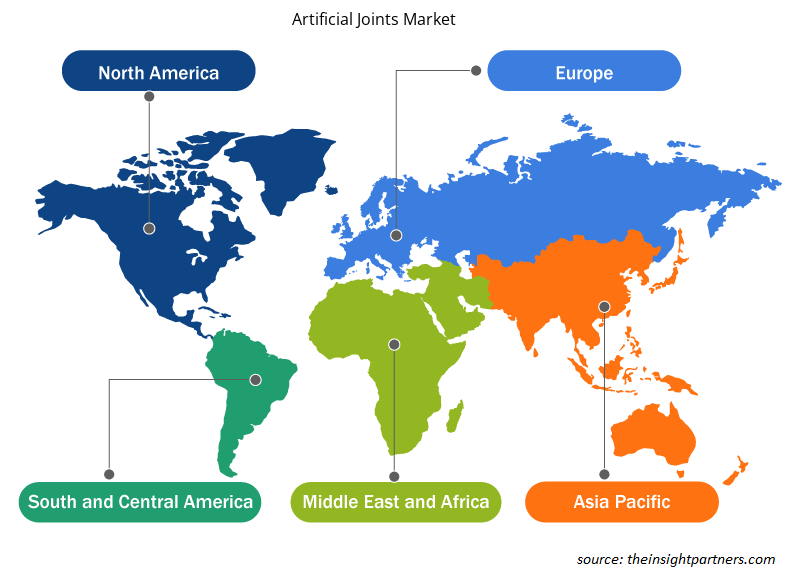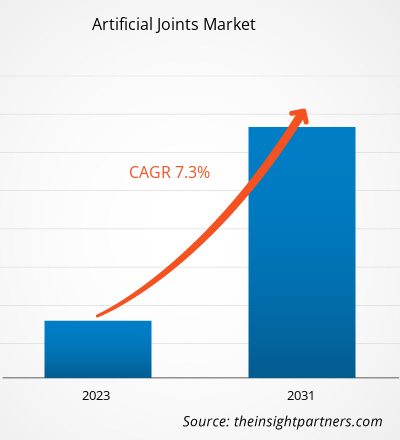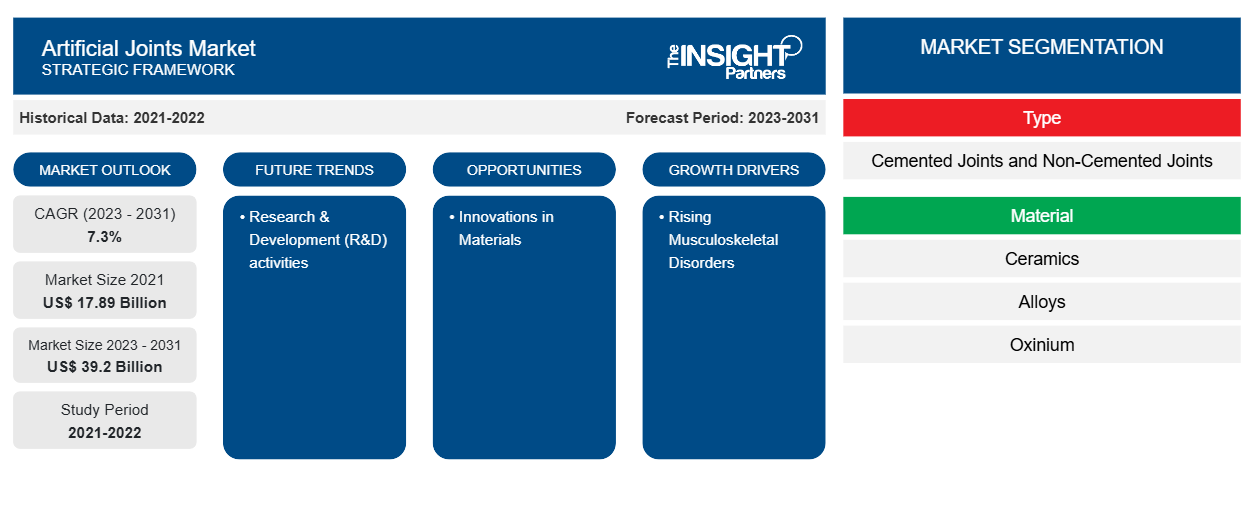Il mercato delle articolazioni artificiali è stato valutato a 17,89 miliardi di dollari nel 2021 e si prevede che raggiungerà i 39,2 miliardi di dollari entro il 2031. Si prevede che il mercato registrerà un CAGR del 7,3% dal 2023 al 2031. È probabile che le attività di ricerca e sviluppo (R&S) rimangano tendenze chiave del mercato delle articolazioni artificiali.
Analisi di mercato delle articolazioni artificiali
Aumento dei disturbi muscoloscheletrici
Le sostituzioni articolari sono diventate un fattore intrinseco per la manutenzione e il ripristino per trattare un'ampia gamma di problemi muscoloscheletrici tra i disturbi muscoloscheletrici. Ad esempio, nel 2019, in Inghilterra, sono state eseguite più di 200.000 sostituzioni di anca e ginocchio, con 189 sostituzioni di anca e 130 di ginocchio. Pertanto, con l'aumento dei disturbi muscoloscheletrici, c'è una domanda accelerata di articolazioni artificiali. Le moderne articolazioni artificiali sono prodotti ad alta tecnologia realizzati con materiali specializzati utilizzando attrezzature tecnologiche uniche. Questi progetti sono giustificati e progettati in base a metodi di analisi del sistema, allo stato fisiologico dei pazienti e all'eliminazione delle complicazioni. Pertanto, lo sviluppo di moderne articolazioni artificiali con opzione chirurgica non invasiva, meno dolorosa per i pazienti sono i fattori più influenti responsabili della crescita del mercato delle articolazioni artificiali durante il 2021-2031.
Giunti artificialiPanoramica del mercato
Tecnologia, innovazione e soluzioni tecnologiche intelligenti come continuano a influenzare significativamente le articolazioni artificiali. L'aumento dei disturbi muscoloscheletrici e le tecnologie intelligenti nelle articolazioni artificiali sono i fattori più influenti responsabili della crescita del mercato delle articolazioni artificiali. Le attività di ricerca e sviluppo (R&S) sono una tendenza chiave per la crescita del mercato delle articolazioni artificiali. Le innovazioni nei materiali forniranno opportunità di mercato redditizie.
Personalizza questo report in base alle tue esigenze
Riceverai la personalizzazione gratuita di qualsiasi report, comprese parti di questo report, o analisi a livello nazionale, pacchetto dati Excel, oltre a usufruire di grandi offerte e sconti per start-up e università
-
Scopri le principali tendenze di mercato in questo rapporto.Questo campione GRATUITO includerà analisi di dati che spaziano dalle tendenze di mercato alle stime e alle previsioni.
Giunti artificialiFattori di mercato e opportunità
Tecnologie intelligenti nelle articolazioni artificiali per favorire il mercato
Manufacturers want to design smart orthopaedic implants that monitor progression in patients. Webster is one such manufacturer that is in the process of development of smart orthopaedic implants that monitor patients progression and then transmit the information to healthcare professionals through radio and a handheld device. If infection occurs, the implants could not only alert doctors, but also can release a drug. Traditionally, strong and lightweight titanium is a material choice for artificial implants. However, Webster is using a different material other than titanium with an oxidized surface that's coated with carbon nanotubes with working as an electrode. By applying a voltage and measuring the conductivity of the implant surface, doctors could use the nanotubes to sense one of the three things that can happen to an implant. Therefore, smart artificial joints will take a considerable market in the coming years and even top manufacturers like Zimmer Biomet will develop devices that will overcome traditional artificial joints implants methods.
Innovations in Materials for Artificial Joints Market– An Opportunity
With innovation in surgical techniques, procedures like hip replacements and knee operations have become a common practice. Additionally, innovation in artificial joint materials will provide lucrative market opportunities for the manufacturers in the long run. For example, the development of a patented type of nylon can be used as an extra coating on top of the plastic surface of a replacement joint. This surface covers the ball part of a ball-and-socket joint, usually composed of an "ultra-high-molecular-weight polyethylene (UHMWPE)" material. Additionally, experiments are still being done using nylon coating to merge with the UHMWPE to create a new material with exciting characteristics. Therefore, material innovation in artificial joints will provide lucrative market opportunities accounting for considerable market share in the coming years.
Artificial Joints
Market Report Segmentation Analysis
Key segments that contributed to the derivation of the Artificial Joints Market analysis are candidature and services.
- Based on Type, the Artificial Joints Market is bifurcated into cemented joints and non-cemented joints. The cemented joints may hold a larger market share in 2023.
- Based on Material, the Artificial Joints Market is segmented into ceramics, alloys, oxinium, and others. The ceramics may hold a larger market share in 2023.
- Based on Application, the Artificial Joints Market is segmented into artificial joints of knee, artificial joints of hip, artificial joints of shoulder, and others. The artificial joints of knee may hold a larger market share in 2023.
- Based on End User, the Artificial Joints Market is segmented into Hospitals, Ambulatory Care Centers, and Others. The Hospitals may hold a larger market share in 2023.
Artificial Joints Market Share Analysis by Geography
The geographic scope of the Artificial JointsMarket report is mainly divided into five regions: North America, Asia Pacific, Europe, Middle East & Africa, and South America/South & Central America.
North America has dominated the Artificial Joints Market. In North America, US accounts considerable share for artificial joints. Presence of top medical manufacturers present in the US and rising R&D activities in terms of materials are the most influential factors responsible for market growth. Asia Pacific is anticipated to grow with the highest CAGR in the coming years.
Artificial Joints
Market Report Scope
Artificial Joints Market Regional Insights
The regional trends and factors influencing the Artificial Joints Market throughout the forecast period have been thoroughly explained by the analysts at Insight Partners. This section also discusses Artificial Joints Market segments and geography across North America, Europe, Asia Pacific, Middle East and Africa, and South and Central America.

- Get the Regional Specific Data for Artificial Joints Market
Artificial Joints Market Report Scope
| Report Attribute | Details |
|---|---|
| Market size in 2021 | US$ 17.89 Billion |
| Market Size by 2031 | US$ 39.2 Billion |
| Global CAGR (2023 - 2031) | 7.3% |
| Historical Data | 2021-2022 |
| Forecast period | 2023-2031 |
| Segments Covered |
By Type
|
| Regions and Countries Covered |
North America
|
| Market leaders and key company profiles |
|
Market Players Density: Understanding Its Impact on Business Dynamics
The Artificial Joints Market market is growing rapidly, driven by increasing end-user demand due to factors such as evolving consumer preferences, technological advancements, and greater awareness of the product's benefits. As demand rises, businesses are expanding their offerings, innovating to meet consumer needs, and capitalizing on emerging trends, which further fuels market growth.
Market players density refers to the distribution of firms or companies operating within a particular market or industry. It indicates how many competitors (market players) are present in a given market space relative to its size or total market value.
Major Companies operating in the Artificial Joints Market are:
- Zimmer Biomet,
- Smith & Nephew,
- Stryker,
- Medtronic,
- Johnson & Johnson Services, Inc.,
- Exactech, Inc.,
Disclaimer: The companies listed above are not ranked in any particular order.

- Ottieni una panoramica dei principali attori del mercato delle articolazioni artificiali
Giunti artificialiNotizie di mercato e sviluppi recenti
Il mercato delle articolazioni artificiali viene valutato raccogliendo dati qualitativi e quantitativi dopo la ricerca primaria e secondaria, che include importanti pubblicazioni aziendali, dati associativi e database. Di seguito è riportato un elenco degli sviluppi nel mercato delle articolazioni artificiali e delle strategie:
- Nel febbraio 2020, RSIP Vision ha annunciato l'introduzione di una tecnologia di visione basata su computer per visualizzare con maggiore precisione l'osso prima delle procedure di sostituzione dell'anca e del ginocchio, riducendo così l'errore umano.
Giunti artificialiCopertura del rapporto di mercato e risultati
Il rapporto "Dimensioni e previsioni del mercato delle articolazioni artificiali (2021-2031)" fornisce un'analisi dettagliata del mercato che copre le seguenti aree:
- Dimensioni e previsioni del mercato a livello globale, regionale e nazionale per tutti i segmenti di mercato chiave coperti dall'ambito
- Dinamiche di mercato come fattori trainanti, vincoli e opportunità chiave
- Principali tendenze future
- Analisi dettagliata delle cinque forze PEST/Porter e SWOT
- Analisi di mercato globale e regionale che copre le principali tendenze di mercato, i principali attori, le normative e gli sviluppi recenti del mercato
- Analisi del panorama industriale e della concorrenza che copre la concentrazione del mercato, l'analisi della mappa di calore, i principali attori e gli sviluppi recenti
- Profili aziendali dettagliati
- Analisi storica (2 anni), anno base, previsione (7 anni) con CAGR
- Analisi PEST e SWOT
- Valore/volume delle dimensioni del mercato - Globale, Regionale, Nazionale
- Industria e panorama competitivo
- Set di dati Excel
Report recenti
Testimonianze
Motivo dell'acquisto
- Processo decisionale informato
- Comprensione delle dinamiche di mercato
- Analisi competitiva
- Analisi dei clienti
- Previsioni di mercato
- Mitigazione del rischio
- Pianificazione strategica
- Giustificazione degli investimenti
- Identificazione dei mercati emergenti
- Miglioramento delle strategie di marketing
- Aumento dell'efficienza operativa
- Allineamento alle tendenze normative























 Ottieni un campione gratuito per - Mercato delle articolazioni artificiali
Ottieni un campione gratuito per - Mercato delle articolazioni artificiali